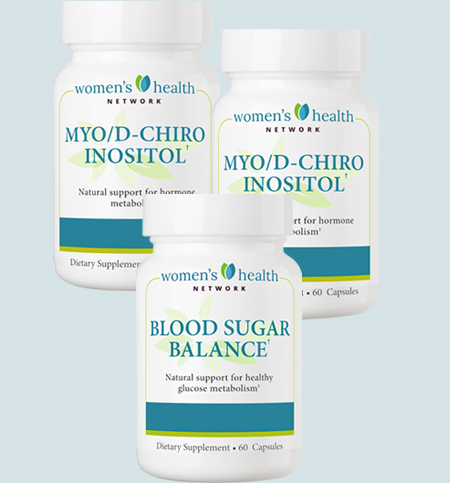Authored by Dr. Sharon Stills, NMD
Is it possible to improve your fertility with PCOS (polycystic ovarian syndrome)? For many women, the fear of not being able to get pregnant is the first thing that comes to mind when they discover they are suffering from PCOS.
Here’s the good news. While it’s true that PCOS is one of the major causes of infertility in women, there are many ways to increase the chance of getting pregnant. Some women may need to work with their doctors for treatment, but many others find that they are able to naturally balance their hormones and increase their changes for getting pregnant.

Why does PCOS affect your fertility?
PCOS is a form of hormonal imbalance that can make fertility and conception more complicated by altering the hormonal mechanisms in your body that produce eggs and prepare the uterus for pregnancy. Many women who suffer from PCOS are also typically dealing with insulin resistance, also known as impaired sugar tolerance.
Becoming pregnant or staying pregnant may be more challenging for women with PCOS due to the following unpredictable effects it has on your body:
- Women with PCOS may not ovulate regularly or at all. This can occur even if you are experience regular periods.
- Women with PCOS suffer from irregular periods rather than the “textbook” regular monthly cycles which provide them with more predictable windows of fertility.
- Women with PCOS may suffer from difficult periods, bleeding heavily for days or weeks, if the uterine lining has gotten too thick and the body must shed it.
- When and if an egg is released, the endometrium (lining of the uterus) may not be able to support implantation and sustain pregnancy.
We are learning about more and more treatment options — including both conventional and natural measures — that can tip the hormonal scales back toward normal and increase the potential for pregnancy. For many women with PCOS, diet and lifestyle changes are a very helpful way to support regular menstrual cycles and increase the chances of getting pregnant naturally.
5 steps to improve your fertility with PCOS

1. Start a low-glycemic load diet. The most important step to balance sex hormones and increase fertility is to follow a low-glycemic load diet. Your goal is to limit out-of-control increases in your blood sugar and insulin levels by reducing your overall carbohydrate intake to 16 grams of carbs per meal and 7 grams per snack. If you’re more active, you may need a slightly higher carb intake. Here are some of the most effective ways to reduce your glycemic load:
- Cut out refined carbohydrates. These include high-fructose syrups, sugar, white flour, white rice, white potatoes and other highly processed, refined sugars and starches. Reducing the amount of refined carbohydrates in your diet is critical to improving your fertility because it reduces your insulin resistance, decreases androgens, and results in more regular ovulation and menstrual cycle.
- Focus on complex carbohydrates, such as those found in vegetables, fruit, legumes, nuts and whole grains. Complex carbohydrates take longer for your body to digest, which helps maintain healthier insulin and blood sugar levels.
- When you eat carbohydrates, combine them with fiber, protein and/or healthy fats. Pairing carbohydrates with these foods will help slow down digestion and lower the insulin spike. Having whole wheat toast? Top it off with some avocado for your healthy fat and an egg for protein!
2. Maintain a healthy weight and stay physically active. Obesity is a significant issue for 35–60% of women with PCOS. What’s more, a high waist-to-hip ratio is linked with high insulin, androgen and estrogen levels that can affect fertility. Simply losing just 5% of your weight can lead to more regular menstrual cycles and ovulation. In addition to reducing your intake of carbohydrates, regular exercise also helps you stay at a healthy weight and reduce insulin resistance. Any type of exercise that you enjoy enough to do on a regular basis will help.
3. Try nutrients and herbs for hormonal support. Vitamins, minerals and herbs provide the daily nutritional support can help restore hormonal imbalance and help relieve your symptoms. In addition to helping to improve fertility, nutrients and herbs can help reduce other troubling symptoms that you may be experiencing with PCOS.
One of the most effective supplements for improving insulin sensitivity is inositol, a form of sugar naturally found in the body that assists with healthy cellular development and function. Inositol, especially in the forms myo-inositol and d-chiro inositol, helps to improve insulin function, bring regularity back to menstrual cycles and improve fertility outcomes for women with PCOS. As an added benefit, research has shown that myo-inositol can help reduce elevated testosterone levels and promote regular ovulation.
Along with inositol, several herbs and the mineral chromium are known to support healthy blood sugar levels and improve insulin resistance:
- Berberine: A potent compound that can help improve insulin sensitivity and reduce glucose levels.
- Bitter melon: Often used in traditional medicine, bitter melon may help manage blood sugar by mimicking insulin action.
- Gymnema sylvestre: Known to help reduce sugar cravings and support healthy blood sugar levels.
- Chromium: Supplementing with the mineral chromium may help improve insulin sensitivity and glucose metabolism in individuals with PCOS.
To take all the guesswork out of using natural support for your PCOS symptoms, our PCOS Support Combo provides you with the correct dose and ratio of inositol, herbs and other key nutrients for PCOS symptom relief.
4. Support your emotional health. It isn’t always easy, but it’s important to take whatever steps you can to reduce stress and create a balanced life. Women with PCOS describe may be more anxious. And it makes a lot of sense that women who experience difficulty conceiving also report higher rates of depression. We strongly encourage you to make it a priority to find the support you need! You may find support through friends or family, but there another option may be taking a look websites such as PCOS Diva, PCOS Challenge, and InCyst on the Best!, which offer information, support, suggestions and tips for women with PCOS, whether you’re trying to conceive or not.
5. Detoxify. You may not realize how many toxins you use in the typical day Eliminate endocrine disruptors that have been shown to disrupt hormonal balance! For example, the ovaries are highly sensitive to bisphenol A (BPA), a widespread industrial chemical found in plastic food containers. A simple step to detoxify is to use ceramic, glass or stainless steel containers instead.
Other endocrine-disrupting chemicals are found in cosmetics, cleaning products, pesticides and hair care products. You can learn more about some of the most common endocrine disruptors – and simple ways to avoid them – in our article Endocrine disruptors – tipping the hormonal scale.
Putting it all together
If you’ve found out you have PCOS and naturally want to improve your fertility, we suggest you try the dietary and lifestyle recommendations above for at least four to six months to see if your menstrual cycles become more regular. To help make all of the changes easier to incorporate into your life, we have put many of the steps together in our Hormonal Health: PCOS Program.
You may also want to talk with your healthcare practitioner about possible treatments. Remember, each of us is unique when it comes to our hormones – and so are the solutions for hormonal imbalance. The most important thing to realize is that you may have more options that you may realize when it comes to improving your fertility with PCOS and feeling better.
1 Badawy, A., & Elnashar, A. 2011. Treatment options for polycystic ovary syndrome. Int. J. Women’s Health, 3, 25-35. URL: https://www.ncbi.nlm.nih.gov/pmc/articles/PMC3039006/?tool=pubmed (accessed 05.05.2011).
2 Azziz, R., et al. 2004. The prevalence and features of the polycystic ovary syndrome in an unselected population. J. Clin. Endocrinol. Metab., 89 (6), 2745–2749. URL: https://jcem.endojournals.org/cgi/content/full/89/6/2745 (accessed 05.03.2011).
3 NIH | US Department of Health and Human Services. 2008. Beyond infertility: Polycystic ovary syndrome (PCOS). URL (PDF): https://www.nichd.nih.gov/publications/pubs/upload/PCOS_booklet.pdf (accessed 05.04.2011).
4 Teede, H., et al. 2011. Assessment and management of polycystic ovary syndrome: Summary of an evidence–based guideline. MJA, 195 (6), S65–S112. URL: https://www.mja.com.au/public/issues/195_06_190911/tee10915_fm.html (accessed 10.14.2011).
5 Legro, R. 2007. Pregnancy considerations in women with polycystic ovary syndrome. Clin. Obstet. Gynecol., 50 (1), 295–304. URL (abstract): https://www.ncbi.nlm.nih.gov/pubmed/17304043 (accessed 05.04.2011).
6 Nestler, J. 2000. Obesity, insulin, sex steroids and ovulation. Int. J. Obes., 24 (2), S71–S73. URL (abstract): https://www.nature.com/ijo/journal/v24/n2s/abs/0801282a.html (accessed 10.14.2011).
7 NIH | US Department of Health and Human Services. 2008. NIH Pub. No. 08-5863.
8 Wehr, E., et al. 2011. Effect of vitamin D3 treatment on glucose metabolism and menstrual frequency in PCOS women-a pilot study. J. Endocrinol. Invest. [Epub ahead of print] URL (abstract): https://www.ncbi.nlm.nih.gov/pubmed/21613813 (accessed 10.14.2011).
Selimoglu, H., et al. 2010. The effect of vitamin D replacement therapy on insulin resistance and androgen levels in women with polycystic ovary syndrome. J. Endocrinol. Invest., 33 (4), 234-238. URL (abstract): https://www.ncbi.nlm.nih.gov/pubmed/19820295 (accessed 10.14.2011).
9 O’Connell, B. 2001. Select vitamins and minerals in the management of diabetes. Diabetes Spectrum, 14 (3), 137–148. URL: https://spectrum.diabetesjournals.org/cgi/content/full/14/3/133 (free full text; accessed 03.30.2007).
10 Moran, L., et al. 2006. Effects of lifestyle modification in polycystic ovarian syndrome. Reprod. Biomed. Online, 12 (5), 569-578. URL (abstract): https://www.ncbi.nlm.nih.gov/pubmed/16790100 (accessed 05.05.2011).
11 Mayo Clinic staff. 2009. Polycystic ovary syndrome: Symptoms. URL: https://www.mayoclinic.com/health/polycystic-ovary-syndrome/DS00423/DSECTION=symptoms (accessed 04.20.2011).
Legro, R. 2007.
12 Patel, S., & Nestler, J. 2006. Fertility in polycystic ovary syndrome. Endocrinol. Metab. Clin. North Am., 35 (1), 137-155, vii. URL: https://www.ncbi.nlm.nih.gov/pubmed/16310646 (accessed 05.05.2011).
13 Kandaraki, E., et al. 2011. Endocrine disruptors and polycystic ovary syndrome (PCOS): Elevated serum levels of bisphenol A in women with PCOS. J. Clin. Endocrinol. Metab., 96 (3), E480–484. URL (abstract): https://www.ncbi.nlm.nih.gov/pubmed/21193545 (accessed 10.14.2011).
Wilson, C. 2011. Reproductive endocrinology: Bisphenol A and PCOS. Nat. Rev. Endocrinol., 7, 187. URL (intro): https://www.nature.com/nrendo/journal/v7/n4/full/nrendo.2011.26.html (accessed 03.23.2011).











